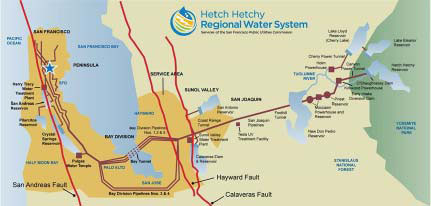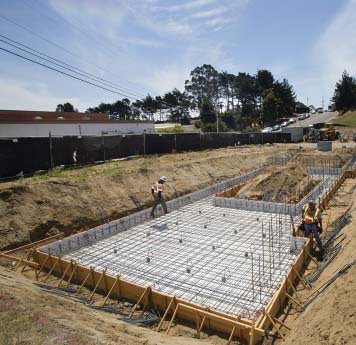Leading The (Re)Charge: How The SFPUC Is Protecting San Francisco Bay Area Groundwater
By Greg Bartow
The Hetch Hetchy Regional Water System is vulnerable to both drought and earthquakes, but innovative resiliency efforts by the San Francisco Public Utilities Commission (SFPUC) will keep the water flowing.
Since the 1930’s, the San Francisco Public Utilities Commission (SFPUC) has been largely reliant upon the iconic Hetch Hetchy reservoir and its water, originating in the Tuolumne River Watershed.
Much of the Hetch Hetchy Regional Water System’s supplies travel the width of the state of California to reach Bay Area taps and cross three active earthquake faults. In 2008, the SFPUC’s Commission charted the current water-supply strategy and included direction to diversify its water supply by developing additional groundwater and recycled water supplies. Amidst California’s historic drought, building the infrastructure to diversify the SFPUC’s water supply, specifically during a severe drought or emergency, is critical now more than ever.

The blue star represents the Regional Groundwater Storage and Recovery Project within the Hetch Hetchy Regional Water System.
Leading the charge to naturally recharge groundwater in the San Francisco Bay Area, the SFPUC’s Regional Groundwater Storage and Recovery Project (Project) is the first of its kind by the SFPUC to form a partnership for storing water underground during dry years. The Project accomplished this by using an In-Lieu Conjunctive Use Agreement developed as a regional partnership between the SFPUC and three of its wholesale customers: the City of Daly City, the City of San Bruno, and the California Water Service Company. These agencies operate their own groundwater wells in addition to distributing SFPUC surface water to their customers. This is the first new water storage that the SFPUC has developed since 1965, and it is one of more than 80 projects that are a part of the SFPUC’s $4.8 billion Water System Improvement Program to repair, replace, and seismically upgrade the Hetch Hetchy Regional Water System.
The SFPUC began the planning, environmental review, and design for this Project over 10 years ago. Now in construction, the Project will provide the SFPUC with dry-year storage in San Mateo County and a backup water supply after an emergency. The Project’s new regional dry-year water supply will be able to provide approximately 7.2 MGD from the South Westside Groundwater Basin (San Mateo County, CA). This Project balances the use of groundwater and surface water to increase dry-year water supplies.

In dry years, groundwater is pumped from storage — the “water savings account”.
During years of normal or above-average rainfall, the SFPUC will provide up to 5.5 MGD of additional surface water to the Project’s partner agencies in lieu of their groundwater pumping. Over time, the reduced pumping will result in the storage of up to 60,500 acre-feet or 20 billion gallons of water. The SFPUC will only pump groundwater that has been previously stored — thus ensuring the sustainability of the project.

In wet years, municipal pumping is decreased and groundwater fills the available aquifer storage space.
The Project is currently installing up to 16 new groundwater wells and well stations, including chemical treatment equipment, tanks, pumping systems, and associated pipelines to extract, treat, and distribute stored groundwater in dry years. It is designed to help meet water demands during a 7.5-year-long drought (i.e., recovery of 8,050 acre-feet per year), thereby stretching the SFPUC’s regional water resources. This dry-year supply will benefit all 2.6 million customers who depend on the SFPUC for all or part of their water supply.

The construction team is now on the second phase of work, which includes the well facility development. Each well facility will have various rooms to monitor, test, and pump water if needed.
Two types of well stations are being built — wells housed inside buildings with separate rooms for the well and chemical treatment and wells housed in outdoor, fenced enclosures without chemical treatment. Wells housed indoors will have vertical turbine deep well pumps and variable frequency drives. Wells housed outdoors have submersible pumps to avoid noise impacts. The water from these wells will be pumped to the indoor well stations or partner facilities for treatment. All of the groundwater will be chlorinated and, depending on the location, water quality, and point of connection, groundwater may also be adjusted for pH, fluoridated, and filtered for manganese.
The Project’s wells and well pumps are designed to operate in a range of changing groundwater water levels — i.e., to accommodate higher water levels during the initial years of recovery and lower water levels following multiple dry years. Over a 7.5-year drought recovery period, existing water levels could decline by up to 100 feet, and pumping water levels could decline by 180 feet.

The drill rig was a critical part to the flow and function of this project. At each site, our construction teams drilled between 400 to 900 feet deep to develop new groundwater wells.
The SFPUC’s ability to deliver high-quality water every day requires proactive planning and infrastructure investment. This is especially true as California faces some of the driest years on record. This Project will help increase San Francisco’s water supply resilience, diversify its water supply portfolio, and reduce dependence on surface water, making the SFPUC’s Hetch Hetchy Regional Water System less vulnerable to natural disasters such as droughts and earthquakes.
About The Author

Greg Bartow is the groundwater program manager for the San Francisco Public Utilities Commission and project manager for the SFPUC’s Regional Groundwater Storage and Recovery Project.
